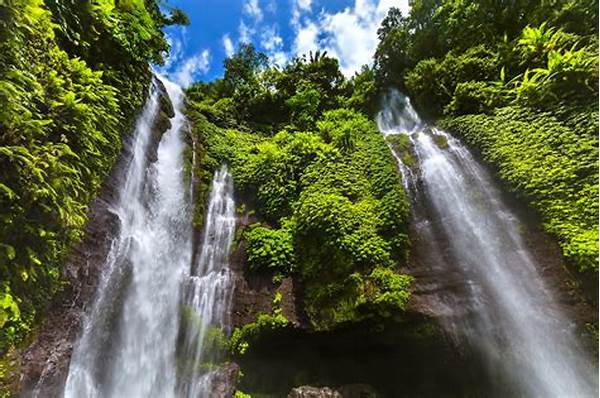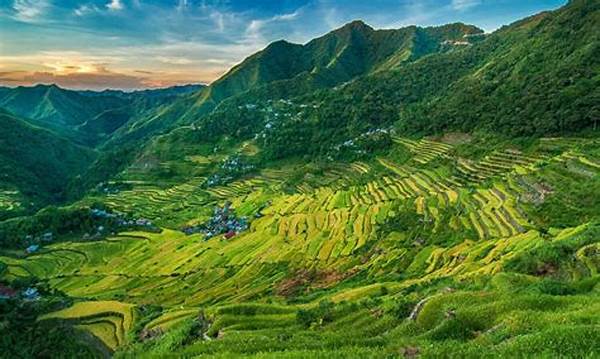Imagine standing before an ethereal cascade of water, hearing the thunderous roar as it crashes into a turquoise pool beneath. Sunlight dances across the mist, creating rainbows that form and fade before your eyes. This isn’t a scene from a fantasy novel; it’s nature tourism: waterfalls in Bali. The tropical paradise of Bali isn’t just known for its beaches and volcanic landscapes. Nestled within its dense jungles and towering mountains are some of the most breathtaking waterfalls you’ll ever encounter. Whether you’re an adventurer seeking thrills, a romantic looking for that idyllic setting, or someone in search of serenity and mindfulness, the waterfalls of Bali cater to every desire.
Read More : Top Waterfalls Among Natural Tourist Attractions In Bali This September
According to recent travel statistics, Bali has seen a significant increase in tourists seeking natural attractions, with waterfalls being a prime focus. This surge in interest isn’t just due to the allure of these natural wonders, but also thanks to savvy marketers capitalizing on the viral potential of mesmerising Instagram feeds filled with these enchanting waterscapes. People are no longer just reading about these places—they’re seeing them, sharing them, and booking flights to experience them firsthand. The global community is buzzing with testimonials praising the rejuvenating power of Bali’s falls, and travelers are eager to swap stories of their own waterfall adventures.
Discover the Best Waterfalls in Bali
Embarking on a journey to explore nature tourism: waterfalls in Bali is more than a hiking trip; it’s an immersion into a world where nature’s beauty enthralls and renews the soul. One must-visit is Sekumpul Waterfall, often touted as Bali’s most beautiful, with a series of seven falls hidden within a lush tropical forest. Accessibility may require a bit of effort—think of a short trek and some stairs—but the reward is a panoramic view that leaves you speechless.
It doesn’t stop at Sekumpul. The adventurous should not miss the Gitgit Waterfall, located nearby the mountainous region of Bedugul. Known for its accessibility, this waterfall offers a more relaxed experience with souvenir shops and cafes lining the path. Watching the water plummet from a height of 35 meters into a clear pool below is as thrilling as it is peaceful.
Meanwhile, for a touch of magic wrapped in folktale, head to Tegenungan Waterfall. Unlike other falls that are nestled in mountain ranges, Tegenungan is conveniently located close to Ubud. Its blend of accessibility and beauty makes it a hotspot, yet its majesty amidst flourishing greenery ensures it never loses an aura of exclusivity.
Experience the Thrill of Off-the-Beaten-Path Waterfalls
For those who favor the road less traveled, nature tourism: waterfalls in Bali provides hidden gems that await discovery. One such treasure is the lesser-known Aling-Aling Waterfall, with its natural waterslides. Adventurers can indulge in cliff jumping or rappel down the cascade, but be prepared for the adrenaline rush!
Not far from Aling-Aling lies Banyumala Twin Waterfalls, a sight to behold with its twin streams cascading down the lush gorge. Despite its stunning beauty, it remains less crowded, offering a private communion with nature for those willing to take on the somewhat demanding trek.
Bali also boasts the mesmerizing aesthetics of Nungnung Waterfall. The challenge comes in the form of 509 steps down to the base, but as the saying goes, the journey is the reward. Once there, the roar of the waterfall drowns out everything else, allowing a moment of pure tranquility.
Tips for Exploring Bali’s Waterfalls
Engaging in nature tourism: waterfalls in Bali requires a bit of prep and know-how to maximize enjoyment and safety. Here’s a handy list to ensure a memorable adventure:
Read More : Mountain Closure News
The Beauty and Importance of Waterfall Conservation
Narrating the story of nature tourism: waterfalls in Bali isn’t complete without addressing conservation efforts. Waterfalls are more than tourist attractions; they are ecosystems supporting diverse flora and fauna, integral to maintaining Bali’s natural balance. Efforts by local organizations emphasize ecological preservation and sustainable tourism to ensure these natural wonders exist for generations to come.
Waterfalls contribute to the replenishment of groundwater, support local agriculture, and foster the biodiversity essential to the island’s cultural fabric. By visiting these sites, tourists can contribute positively, spreading awareness and funding conservation activities. Their importance transcends aesthetics, underscoring the need for thoughtful interactions with these natural marvels.
Summarizing the Magic of Bali’s Waterfalls
In conclusion, nature tourism: waterfalls in Bali provides a multifaceted experience that caters to a wide spectrum of travelers. From those seeking adrenaline rushes and off-the-grid adventures to individuals yearning for peace and introspection, Bali’s waterfalls are an inviting sanctuary. They invite stories of exploration, self-discovery, and unyielding beauty.
Travel enthusiasts and casual tourists alike depart from this lush island with memories that transcend ordinary travel tales. Whether it’s the exhilarating plunge into a hidden pool or a quiet moment with cascading waters as your backdrop, Bali continuously proves why it’s a haven for those who value the sanctity of nature.
These waterfalls aren’t just scenic spots; they embody the spirit of Indonesia, a country rich in culture and natural splendor. As we recount tales of discovery, it’s evident that nature tourism: waterfalls in Bali is more than an experience—it’s a legacy, one in which every visitor plays a crucial role. The invitation is open; come for the sights, stay for the stories, and leave with indelible memories etched in both heart and mind.
The journey to Bali is a call to explore not only the island’s stunning topography but also its commitment to preserving the natural world for posterity. In the grand tapestry of travel experiences, nature tourism: waterfalls in Bali emerges as a masterpiece of both nature’s artistry and humanity’s endeavor to cherish and protect it.


